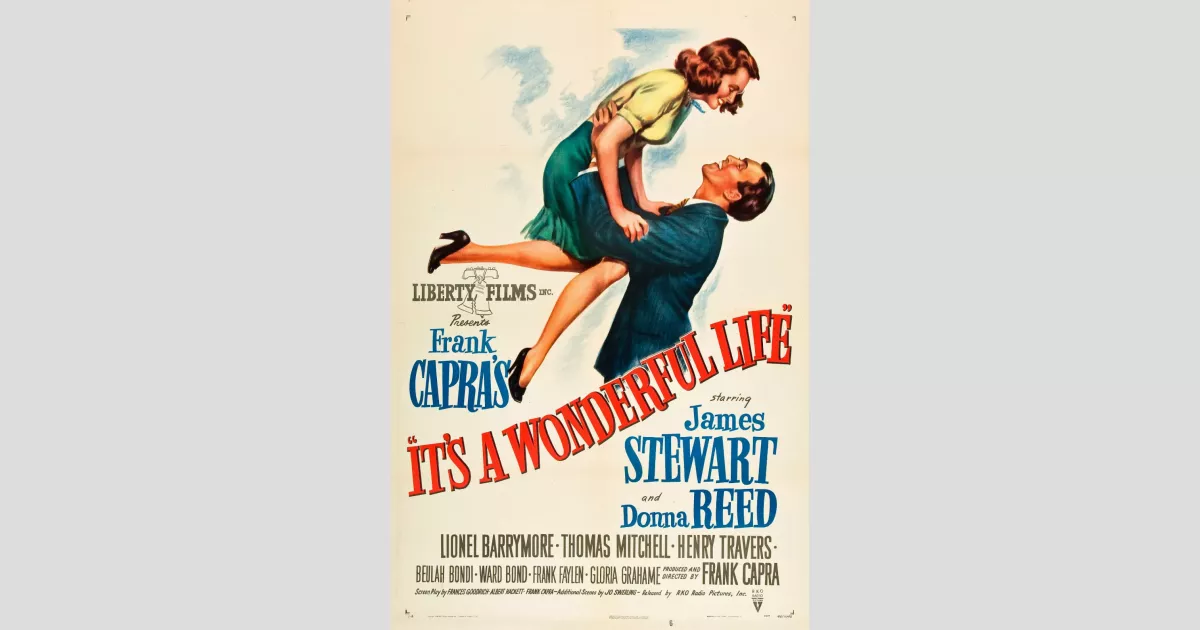It's a Wonderful Life, directed by Frank Capra, tells the story of George Bailey, a selfless man who has always put others before himself in the small town of Bedford Falls. Facing financial ruin due to the machinations of the greedy Mr. Potter, George contemplates suicide on Christmas Eve. Clarence, an angel trying to earn his wings, intervenes and shows George what life would have been like if he had never been born. George witnesses the devastating impact his absence would have on his family and the town, which would have been dominated by Potter. Realizing the value of his life and the positive impact he has had, George returns home with a renewed appreciation for everything he has. The town rallies around him, saving him from financial disaster and reaffirming the importance of community and the inherent worth of every individual.
1927: H. B. Warner played Jesus Christ in The King of Kings
In 1927, H. B. Warner, who played Mr. Gower in 'It's a Wonderful Life', portrayed Jesus Christ in Cecil B. DeMille's film 'The King of Kings'.
1928: George Bailey postpones travel to settle family business
In 1928, George Bailey postpones his world tour and college plans after his father dies, in order to settle the family business, Bailey Brothers Building and Loan.
1931: Original Sets Designed for Cimarron
In 1931, the Oscar-winning sets originally designed by art director Max Ree for the epic film 'Cimarron' were adapted to become "Bedford Falls" for the movie 'It's a Wonderful Life'.
1933: Potential Colorization of Lady for a Day
In 1933, Lady for a Day was considered for colorization by Capra.
1938: Stewart and Capra collaboration on You Can't Take It with You
In 1938, James Stewart and Frank Capra collaborated on the film 'You Can't Take It with You'.
1938: Barrymore worked with Capra and Stewart on You Can't Take It with You
In 1938, Lionel Barrymore worked with Frank Capra and James Stewart on Capra's Best Picture Oscar winner, 'You Can't Take It with You'.
November 1939: Philip Van Doren Stern wrote "The Greatest Gift"
In November 1939, Philip Van Doren Stern wrote the original story, "The Greatest Gift", which would later inspire the film.
1939: Stewart and Capra collaboration on Mr. Smith Goes to Washington
In 1939, James Stewart and Frank Capra collaborated on the film 'Mr. Smith Goes to Washington'.
1941: Potential Colorization of Meet John Doe
In 1941, Meet John Doe was considered for colorization by Capra.
1943: Publication of "The Greatest Gift"
In 1943, Philip Van Doren Stern self-published "The Greatest Gift", a short story and booklet that served as the basis for the film 'It's a Wonderful Life'.
1943: Mailing of "The Greatest Gift" pamphlet
In 1943, after being rejected by several publishers, Philip Van Doren Stern had his story "The Greatest Gift" printed as a 24-page pamphlet and mailed it to 200 family members and friends for Christmas.
April 1944: RKO Pictures bought the rights to "The Greatest Gift"
In April 1944, RKO Pictures purchased the rights to "The Greatest Gift" for $10,000, with plans to create a film starring Cary Grant.
1945: George Bailey's contemplation of suicide
On Christmas Eve in 1945, in Bedford Falls, New York, George Bailey contemplates suicide, prompting divine intervention.
1945: Capra's visit to Seneca Falls
Some in Seneca Falls, New York, believe that in 1945, Frank Capra was inspired to model Bedford Falls after the town following a visit.
April 15, 1946: Filming Commenced
On April 15, 1946, filming for 'It's a Wonderful Life' began at RKO Radio Pictures Studios in Culver City, California, and the RKO movie ranch in Encino.
July 27, 1946: Filming Wrapped
On July 27, 1946, filming for 'It's a Wonderful Life' concluded, meeting the 90-day principal photography schedule deadline.
December 1946: Release Date Moved Up
The release date of 'It's a Wonderful Life' was moved up to December 1946 to make it eligible for the 19th Academy Awards held in March 1947.
December 20, 1946: Premiere of 'It's a Wonderful Life'
On December 20, 1946, 'It's a Wonderful Life' premiered at the Globe Theatre in New York City, receiving mixed reviews.
1946: Release of 'It's a Wonderful Life'
In 1946, 'It's a Wonderful Life', an American Christmas fantasy drama film, was produced and directed by Frank Capra.
1946: Frank Capra Interview
In 1946, Frank Capra stated in an interview that the film's theme is the individual's belief in himself, and that he made it to combat a modern trend toward atheism.
1946: Henry Fonda cast in My Darling Clementine
In 1946, Henry Fonda, was cast in John Ford's 'My Darling Clementine', which was filmed concurrently with 'It's a Wonderful Life'.
1946: James Agee's Review
In 1946, critic James Agee noted that 'It's a Wonderful Life' was one of the most efficient sentimental pieces since 'A Christmas Carol'.
1946: Original Screenplay
In 1946, the original screenplay for 'It's a Wonderful Life' was created, which later inspired the 1977 remake, 'It Happened One Christmas'.
1946: Philip Van Doren Stern interview
In a 1946 interview, Philip Van Doren Stern mentioned that the movie takes place in Westchester County and that Califon, N.J., was the town he had in mind when writing the story.
January 7, 1947: General Release
On January 7, 1947, 'It's a Wonderful Life' was released generally.
January 1947: Initial Release Date
The film 'It's a Wonderful Life' was originally supposed to be released in January 1947, but it was moved up.
March 1947: 19th Academy Awards
In March 1947, 'It's a Wonderful Life' was eligible for the 19th Academy Awards.
May 26, 1947: FBI Memo on It's a Wonderful Life
On May 26, 1947, the Federal Bureau of Investigation issued a memo stating that the film 'It's a Wonderful Life' represented attempts to discredit bankers and maligned the upper class, associating it with Communist tactics.
1947: Review in The New Republic
In 1947, film critic Manny Farber wrote a review for The New Republic, stating that Capra takes a simple-minded path and does not give much credit to the intelligence of the audience, while also acknowledging that there are a few unsentimental moments.
1947: Performance of Lux Radio Theatre script
In 1947, the Lux Radio Theatre script of It's a Wonderful Life was performed.
1947: Radio Adaptations
In 1947, the film was adapted for radio twice: first on Lux Radio Theater on March 10th and then on the Screen Guild Theater on December 29th, with James Stewart and Donna Reed reprising their roles.
May 8, 1949: Radio Adaptation on Screen Directors Playhouse
On May 8, 1949, James Stewart starred in a radio adaptation of It's a Wonderful Life presented on the Screen Directors Playhouse.
March 15, 1951: Radio Adaptation on Screen Guild Theater
On March 15, 1951, It's a Wonderful Life was adapted for radio again on the Screen Guild Theater, with James Stewart and Donna Reed reprising their roles.
1951: Liberty Films Purchased by Paramount Pictures
In 1951, Liberty Films was purchased by Paramount Pictures, remaining a subsidiary.
1954: RKO Movie Ranch Razed
In 1954, RKO's movie ranch in Encino, where 'It's a Wonderful Life' was filmed, was razed.
1955: M. & A. Alexander Purchased the Movie
In 1955, M. & A. Alexander purchased the movie, including key rights to original television syndication, nitrate film elements, music score, and film rights to The Greatest Gift.
1955: Paramount Lost Distribution Rights
Paramount lost distribution rights to It's A Wonderful Life in 1955, rights which the company would regain in 1998.
1971: Copyright Renewal of The Greatest Gift
In 1971, Philip Van Doren Stern renewed the copyright of The Greatest Gift, the story on which the film is based.
1974: Copyright Lapse at NTA
In 1974, a clerical error at NTA prevented the copyright from being renewed properly.
1974: Copyright Expiration and Entry into Public Domain
In 1974, the copyright for 'It's a Wonderful Life' in the U.S. expired due to a lack of renewal, causing it to enter the public domain and allowing broadcasts without licensing fees. This led to the film's rise as a Christmas classic.
1976: Television Staple During Christmas Season
In 1976, three decades after its initial release, the film became a television staple during the Christmas season.
1977: It Happened One Christmas Release
In 1977, the television movie remake 'It Happened One Christmas' was released, based on the original short story and the 1946 screenplay, employing gender-reversal with Marlo Thomas and Wayne Rogers in the lead roles.
1978: It Happened One Christmas Rebroadcast
In 1978, 'It Happened One Christmas' was rebroadcast following positive reviews from its initial release in 1977.
1979: It Happened One Christmas Rebroadcast
In 1979, 'It Happened One Christmas' was rebroadcast again, the last time it was shown on national re-broadcasts, following positive reviews from its initial release in 1977.
1984: Frank Capra's Comments to The Wall Street Journal
In 1984, Frank Capra told The Wall Street Journal that the film has a life of its own, and he feels like a parent whose kid grows up to be President.
1986: Saturday Night Live Skit
In 1986, 'Saturday Night Live' featured a skit presenting a 'lost ending' of It's a Wonderful Life where George Bailey and the citizens attack Mr. Potter.
1986: First Performance of Musical Stage Adaptation
In 1986, A Wonderful Life, a musical stage adaptation by Sheldon Harnick and Joe Raposo, was first performed at the University of Michigan.
1986: First Colorized Version Released
In 1986, the first colorized version of the film was released by Hal Roach Studios.
1989: Second Colorized Version and Re-release
In 1989, a second colorized version was authorized and produced by Republic Pictures, and the Hal Roach color version was re-released to VHS via Video Treasures.
1990: Selection for National Film Registry
In 1990, 'It's a Wonderful Life' was selected for preservation in the National Film Registry by the United States Library of Congress.
1990: U.S. Supreme Court Ruling in Stewart v. Abend
In 1990, the U.S. Supreme Court ruling in Stewart v. Abend (which involved Rear Window) was referenced.
1990: Clarence Television Film
In 1990, the made-for-television film 'Clarence', starring Robert Carradine, was released, telling a new tale of the helpful angel, Clarence Odbody.
1991: Performance by Arena Stage
In 1991, A Wonderful Life, the musical adaptation, was performed in Washington, D.C., by Arena Stage.
1992: Tiny Toon Adventures Parody
In 1992, the final episode of 'Tiny Toon Adventures' parodied It's a Wonderful Life in an episode called 'It's A Wonderful Tiny Toon Christmas'.
1993: Release on CD-ROM for Windows PC
In 1993, Kinesoft Development, with Republic Pictures support, released It's a Wonderful Life on CD-ROM for Windows PC (Windows 3.1).
1993: Republic Pictures Enforces Copyright Claim
In 1993, Republic Pictures, the successor to NTA, enforced its claim to the copyright by relying on the 1990 U.S. Supreme Court ruling in Stewart v. Abend and made a deal with Turner Broadcasting System authorizing only three airings.
April 1994: Computer Gaming World Review
In April 1994, Computer Gaming World reviewed the CD-ROM version, noting the picture quality still needed improvement but calling it a "noble effort".
1994: Jimmy Hawkins wins Young Artist Awards
In 1994, Jimmy Hawkins won a "Former Child Star Lifetime Achievement Award" from the Young Artist Awards, recognizing his role as Tommy Bailey.
1994: NBC Acquires Exclusive Television Rights
In 1994, Republic Pictures sold exclusive television rights to NBC, with NBC planning to broadcast the original director's cut in black and white, full-length.
1995: Inclusion in Vatican's List of Important Films
In 1995, the film was included by the Vatican in a list of important films under the category of "Values".
1996: Elmo Saves Christmas Reference
In 1996, the holiday special 'Elmo Saves Christmas' referenced the rumor of Bert and Ernie being named after characters from 'It's a Wonderful Life'.
1997: PBS Airs "Merry Christmas, George Bailey"
In 1997, PBS aired Merry Christmas, George Bailey, a taped performance of the 1947 Lux Radio Theatre script at the Pasadena Playhouse, benefiting the Elizabeth Glaser Pediatric AIDS Foundation.
1997: Merry Christmas, George Bailey Adaptation
In 1997, PBS released a television movie adaptation titled 'Merry Christmas, George Bailey', starring Bill Pullman, Penelope Ann Miller, Nathan Lane and Martin Landau.
1998: AFI's Greatest Movie List
In 1998, 'It's a Wonderful Life' was ranked no. 11 on the American Film Institute's list of greatest movies.
1998: Viacom Acquires Republic's Parent Company
In 1998, Viacom acquired Republic's then-parent company, Spelling Entertainment, resulting in Paramount once again having distribution rights.
1998: Mention During Copyright Term Extension Act Deliberations
In 1998, the film was mentioned during the deliberations on the Copyright Term Extension Act.
1999: San Francisco Chronicle Correction
In 1999, the San Francisco Chronicle issued a correction to their 'Annual Xmas Quiz' which claimed that Bert and Ernie on Sesame Street were named after characters in 'It's a Wonderful Life'. Jerry Juhl confirmed the shared names were merely a coincidence.
2001: DVD Release
In 2001, It's a Wonderful Life saw its first DVD release
2002: Channel 4's Ranking
In 2002, Channel 4 in the United Kingdom ranked 'It's a Wonderful Life' as the seventh-greatest film ever made in its poll "The 100 Greatest Films".
2002: DVD Release in Australia
In 2002, It's a Wonderful Life was released on DVD in Australia by Magna Pacific and MRA Entertainment
2004: DVD Re-releases
In 2004, Republic re-released It's a Wonderful Life on DVD twice in the same year with different packaging.
2005: Staged Concert Version in New York City
In 2005, A Wonderful Life, the musical adaptation, had a staged concert version in New York City.
2005: Home Video Rights Revert to Paramount
In late 2005, Lions Gate Entertainment, which had acquired Artisan Entertainment, saw the US home video rights revert to Paramount.
October 31, 2006: "60th Anniversary Edition" DVD Release
On October 31, 2006, Paramount released a newly remastered "60th Anniversary Edition" of It's a Wonderful Life on DVD.
2006: Post-War movies offering consolation
According to a 2006 book, a spate of movies, including 'It's a Wonderful Life', appeared just after the ending of the Second World War, offering a kind of consolation.
November 13, 2007: "Special Edition" DVD Release with Colorized Version
On November 13, 2007, Paramount released a two-disc "special edition" DVD containing the original black-and-white version and a new colorized version produced by Legend Films.
2007: Third Computer-Colorized Version Produced
In 2007, a third, computer-colorized version was produced by Legend Films and released on DVD, Blu-ray, and streaming services.
2007: AFI's Greatest Movie List
In 2007, the American Film Institute ranked 'It's a Wonderful Life' as no. 20 on its list of greatest movies.
June 2008: AFI's 10 Top 10 Acknowledgment
In June 2008, AFI acknowledged 'It's a Wonderful Life' as the third-best film in the fantasy genre in its 10 Top 10 list.
2008: Article in The New York Times
In 2008, Wendell Jamieson wrote an article for The New York Times, providing a positive analysis of the film, but observing it is a terrifying story about growing up and relinquishing dreams, living among bitter people, and being trapped.
November 3, 2009: "Collector's Edition" and Blu-ray Release
On November 3, 2009, Paramount re-released the previous DVD set as a "Collector's Edition" and debuted a Blu-ray edition, both containing the black-and-white and colorized versions.
December 10, 2010: "It's a Wonderful Life" Museum Opens in Seneca Falls
On December 10, 2010, the "It's a Wonderful Life" Museum opened in Seneca Falls, New York, with Karolyn Grimes, who played Zuzu in the movie, cutting the ribbon.
2010: Essay in Salon
In 2010, Richard Cohen described It's a Wonderful Life as the most terrifying Hollywood film ever made in an essay for Salon.
2011: Warehouse 13 Christmas Episode
In 2011, 'The Greatest Gift', the Christmas episode of season 3 of 'Warehouse 13', aired, telling a similar story to It's a Wonderful Life after agent Pete Lattimer touches Stern's brush.
2011: Publication of "The Last Temptation of Clarence Odbody"
In 2011, John Pierson wrote the novel The Last Temptation of Clarence Odbody, which imagines the future lives of various characters if George had not survived his jump into the river.
2012: Sight & Sound Polls Ranking
In 2012, the film ranked 283rd among critics and 107th among directors in the Sight & Sound polls of the greatest films ever made.
December 1, 2013: The Christmas Spirit Aired
On December 1, 2013, 'The Christmas Spirit', starring Nicollette Sheridan, aired on the Hallmark Channel. The made-for-TV film was set in the present day and was about saving a quiet New England town from a real estate developer. It had 3.372 million viewers overall.
2014: Sequel Production Plans
In early 2014, producers were considering directors and hoped to shoot the film 'It's a Wonderful Life: The Rest of the Story', with a $25–$35 million budget in Louisiana.
2015: Purported Sequel Release
A purported sequel, 'It's a Wonderful Life: The Rest of the Story', was in development for a 2015 release. The film was to follow the angel of George Bailey's daughter Zuzu.
2017: Restoration in 4K Resolution
In 2017, the film was restored in 4K resolution and made available via streaming services and DCP.
July 2019: Announcement of New Stage Musical Adaptation
In July 2019, it was revealed that another stage musical adaptation was in development with music and lyrics by Paul McCartney, lyrics and book by Lee Hall, and produced by Bill Kenwright.
October 29, 2019: 4K Ultra HD Blu-ray Release
On October 29, 2019, the film was released for the first time on 4K Ultra HD Blu-ray, along with a digital copy featuring a new Dolby Vision transfer.
December 2019: Cinematic Audio Adaptation
In December 2019, a new "cinematic audio" adaptation by David Ossman of the Firesign Theatre was produced and directed by Ossman and his wife Judith Walcutt of Otherworld Media at the Whidbey Island Center for the Arts.
2020: Musical Set to Debut
A new musical adaptation of It's a Wonderful Life was set to debut in late 2020, but is yet to premiere.
2021: Value of Technician's Reward
In the movie, during the scene where Uncle Billy knocks over equipment, the technician was rewarded with $10, equal to $141.84 in 2021.
December 2023: Swimming Pool Still in Use
As of December 2023, the swimming pool unveiled during the high-school dance sequence in 'It's a Wonderful Life' is still in use at Beverly Hills High School.
January 2024: Modern Remake in Development
As of January 2024, Paramount Pictures is developing a modern remake of 'It's a Wonderful Life', written and directed by Kenya Barris.
January 19, 2024: Remake Announcement
On January 19, 2024, it was announced that Kenya Barris will write and direct a modern remake of 'It's a Wonderful Life' for Paramount, with the intention to cast a person of color in the role of George Bailey.
2024: Value of $8,000 in 1945
In the movie, on Christmas Eve, Billy deposits $8,000, equivalent to $139,726 in 2024, of the building and loan's money, but misplaces it in Potter's newspaper.
Mentioned in this timeline
Saturday Night Live SNL is a late-night live sketch comedy...

Christmas is an annual festival celebrated on December th commemorating...

Washington D C is the capital city and federal district...

San Francisco is a major commercial financial and cultural hub...
The National Broadcasting Company NBC is a major American commercial...
Australia officially the Commonwealth of Australia encompasses the Australian mainland...
Trending
Coco Gauff began her professional tennis career in She has achieved significant success securing eleven WTA Tour singles titles and...

28 days ago Kayce Dutton's Return: First Look at 'Y: Marshals' Yellowstone Spinoff Trailer

9 months ago Tyler Kolek Impresses, Makes Case for Permanent Spot in Knicks' Rotation After Record.

23 days ago Josh Hart shines with increased workload, making a case to stay in lineup.

7 months ago Tracy Morgan and Others Honored at 2025 'Made in NY' Awards in NYC
1 month ago Delta faces schedule changes due to Oregon pipeline leak, Kotek declares emergency.
Popular

Ben Shapiro is a prominent American conservative political commentator media...

XXXTentacion born Jahseh Dwayne Ricardo Onfroy was a controversial yet...

Candace Owens is an American conservative political commentator and author...

William Franklin Graham III commonly known as Franklin Graham is...
The Kennedy Center Honors are annual awards recognizing individuals and...

Tucker Carlson is an American conservative political commentator known for...


